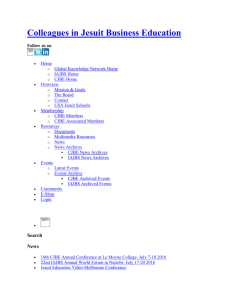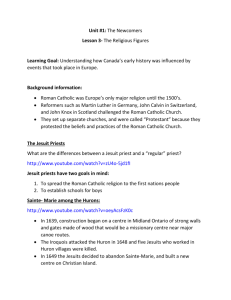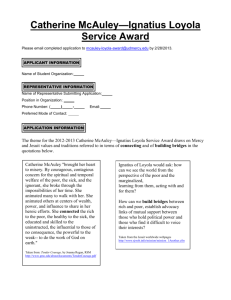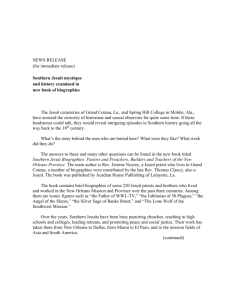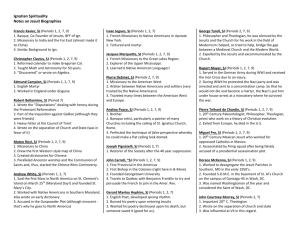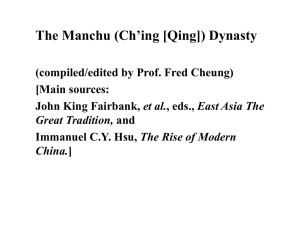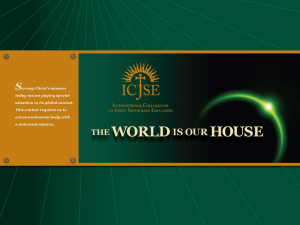Jesuit Asia, Past and Present: India, China, and Japan
advertisement
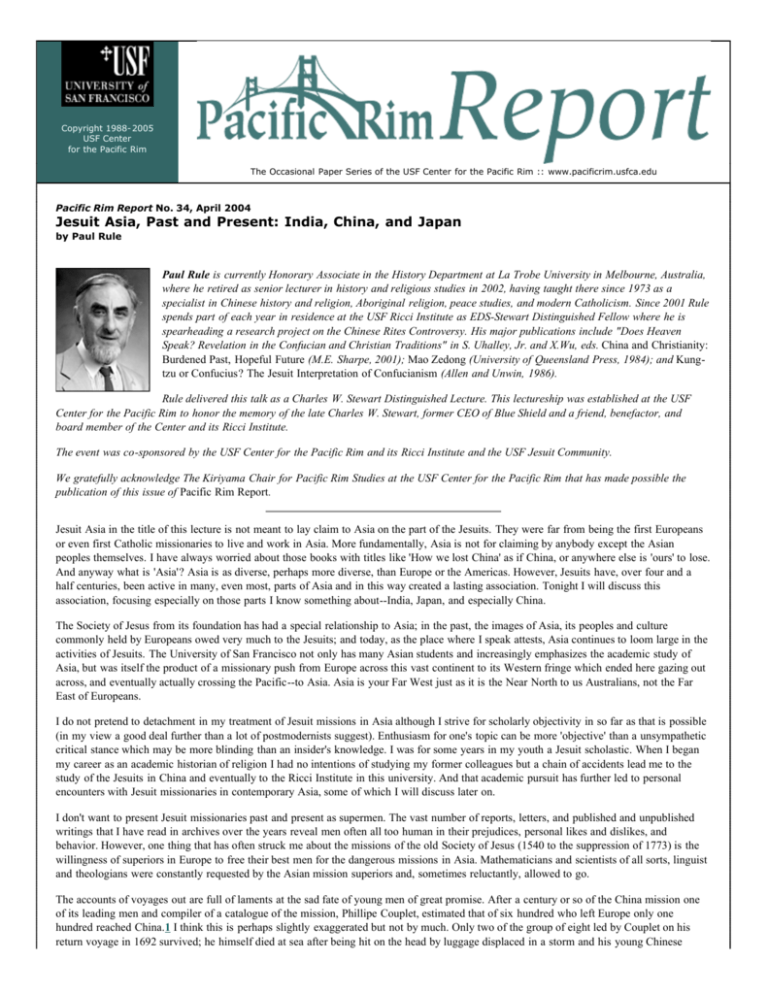
Copyright 1988- 2005 USF Center for the Pacific Rim The Occasional Paper Series of the USF Center for the Pacific Rim :: www.pacificrim.usfca.edu Pacific Rim Report No. 34, April 2004 Jesuit Asia, Past and Present: India, China, and Japan by Paul Rule Paul Rule is currently Honorary Associate in the History Department at La Trobe University in Melbourne, Australia, where he retired as senior lecturer in history and religious studies in 2002, having taught there since 1973 as a specialist in Chinese history and religion, Aboriginal religion, peace studies, and modern Catholicism. Since 2001 Rule spends part of each year in residence at the USF Ricci Institute as EDS-Stewart Distinguished Fellow where he is spearheading a research project on the Chinese Rites Controversy. His major publications include "Does Heaven Speak? Revelation in the Confucian and Christian Traditions" in S. Uhalley, Jr. and X.Wu, eds. China and Christianity: Burdened Past, Hopeful Future (M.E. Sharpe, 2001); Mao Zedong (University of Queensland Press, 1984); and Kungtzu or Confucius? The Jesuit Interpretation of Confucianism (Allen and Unwin, 1986). Rule delivered this talk as a Charles W. Stewart Distinguished Lecture. This lectureship was established at the USF Center for the Pacific Rim to honor the memory of the late Charles W. Stewart, former CEO of Blue Shield and a friend, benefactor, and board member of the Center and its Ricci Institute. The event was co-sponsored by the USF Center for the Pacific Rim and its Ricci Institute and the USF Jesuit Community. We gratefully acknowledge The Kiriyama Chair for Pacific Rim Studies at the USF Center for the Pacific Rim that has made possible the publication of this issue of Pacific Rim Report. Jesuit Asia in the title of this lecture is not meant to lay claim to Asia on the part of the Jesuits. They were far from being the first Europeans or even first Catholic missionaries to live and work in Asia. More fundamentally, Asia is not for claiming by anybody except the Asian peoples themselves. I have always worried about those books with titles like 'How we lost China' as if China, or anywhere else is 'ours' to lose. And anyway what is 'Asia'? Asia is as diverse, perhaps more diverse, than Europe or the Americas. However, Jesuits have, over four and a half centuries, been active in many, even most, parts of Asia and in this way created a lasting association. Tonight I will discuss this association, focusing especially on those parts I know something about--India, Japan, and especially China. The Society of Jesus from its foundation has had a special relationship to Asia; in the past, the images of Asia, its peoples and culture commonly held by Europeans owed very much to the Jesuits; and today, as the place where I speak attests, Asia continues to loom large in the activities of Jesuits. The University of San Francisco not only has many Asian students and increasingly emphasizes the academic study of Asia, but was itself the product of a missionary push from Europe across this vast continent to its Western fringe which ended here gazing out across, and eventually actually crossing the Pacific--to Asia. Asia is your Far West just as it is the Near North to us Australians, not the Far East of Europeans. I do not pretend to detachment in my treatment of Jesuit missions in Asia although I strive for scholarly objectivity in so far as that is possible (in my view a good deal further than a lot of postmodernists suggest). Enthusiasm for one's topic can be more 'objective' than a unsympathetic critical stance which may be more blinding than an insider's knowledge. I was for some years in my youth a Jesuit scholastic. When I began my career as an academic historian of religion I had no intentions of studying my former colleagues but a chain of accidents lead me to the study of the Jesuits in China and eventually to the Ricci Institute in this university. And that academic pursuit has further led to personal encounters with Jesuit missionaries in contemporary Asia, some of which I will discuss later on. I don't want to present Jesuit missionaries past and present as supermen. The vast number of reports, letters, and published and unpublished writings that I have read in archives over the years reveal men often all too human in their prejudices, personal likes and dislikes, and behavior. However, one thing that has often struck me about the missions of the old Society of Jesus (1540 to the suppression of 1773) is the willingness of superiors in Europe to free their best men for the dangerous missions in Asia. Mathematicians and scientists of all sorts, linguist and theologians were constantly requested by the Asian mission superiors and, sometimes reluctantly, allowed to go. The accounts of voyages out are full of laments at the sad fate of young men of great promise. After a century or so of the China mission one of its leading men and compiler of a catalogue of the mission, Phillipe Couplet, estimated that of six hundred who left Europe only one hundred reached China.1 I think this is perhaps slightly exaggerated but not by much. Only two of the group of eight led by Couplet on his return voyage in 1692 survived; he himself died at sea after being hit on the head by luggage displaced in a storm and his young Chinese Jesuit protegé Michael Shen Fuzong who had delighted the kings of France and England died of fever off Mozambique. Only five of Martino Martini's group of seventeen survived the 1657 sailing, and two of the twelve in 1674. Yet. despite the risk, many more volunteered than were permitted to go and amongst those who died as well as those who reached the missions were some of the most brilliant young Jesuits from the Roman College and other Jesuit colleges in Europe. Why did they go to Asia? Let me begin by making a big claim: that Jesuit missions in the East are not just part of the larger picture of Jesuits in the world but lie at the very roots of the Society of Jesus. The first group of Jesuits came together in Paris with the intention of going to the Holy Land as Ignatius Loyola himself had done during the long spiritual and physical pilgrimage that led up to that moment. When they could not leave Venice for the East because of war with the Turks, they placed themselves at the disposal of the pope for any mission he might assign them. In the Formula which was the result of their deliberations and the basis of papal approval they proclaimed their aims as one of mission.2 The order of priority for such missions is interesting: 'whether he sends us to the Turks or any other infidels, even those who live in the parts called the Indies, to any heretics whatever, or schismatic, or any of the faithful'.3 In other words, the old image of the Jesuits as 'shock-troops of the Counter-Reformation' which is strengthened by the military metaphors used by the old soldier Ignatius in the Spiritual Exercises and the standard translation of the title of the chief superior, Praepositus generalis as 'General', is misleading. The Society of Jesus was in origin not a militant but a missionary order, has been so throughout its history, and remains so today. The Jesuit missions in Asia began, as many of you would know, almost by accident. The new Society had not yet been approved when in early 1540 the King of Portugal asked for men to be sent to the Indies where the new churches had been entrusted to his patronage. Two men were allocated; one fell ill on the eve of departure from Rome. Ignatius Loyola had no one to replace him except his beloved and invaluable secretary, Francis Xavier. When he and Simon Rodrigues got to Lisbon, Rodrigues was retained to set up a Portuguese province of the Society, and so, all alone, Francis Xavier begins his career as apostle of Asia, and founder of the Jesuit missions in Asia. The Portuguese connection, the Padroado, or 'patronage' granted by the papacy over the nascent Catholic Church of Asia was an important factor in the history of the old Jesuit missions in Asia. In the New World, similarly, the Padroado in Brazil and the Spanish Patronato in the rest of the America and the Philippines played a big role in many controversies the Jesuits were embroiled in: the Chinese Rites controversy, the disputes with the Vicars Apostolic sent by Rome, internal disputes between French and 'Portuguese'4 Jesuits, the arguments about the Jesuit 'Reductions' in South America. As Portugal's power and wealth waned in the late Seventeenth/Eighteenth centuries the Padroado became more of a hindrance than an aid to missionizing and it was ironically Portugal under Pombal which began the process which led to the suppression of the Jesuits in 1773. But for most of the history of the old mission most of the Jesuits remained loyal to Portugal and they made common cause. As a postscript, I would add that a Jesuit had a key role in the final dismantling of the Padroado. After many years of ecclesiastical warfare between the Portuguese and the British over the See of Bombay, Rome decided Portuguese and British archbishops would alternate. When the Portuguese archbishop died in 1937 it was the turn of the British and a kind of precedent had been established of appointing an English Jesuit. Tom Roberts, an obscure parish priest in Liverpool, was chosen--he always claimed by mistake--and after sizing up the situation decided that it was absurd and the only solution was to appoint an Indian. So he worked hard for the appointment of an Indian auxiliary. Valerian Gracias was appointed in 1946 then Roberts signed on to a tanker to sail round the world on behalf of the Apostleship of the Sea, the chaplaincy for seamen. In 1950 his resignation was accepted, Gracias became a Cardinal as well as Archbishop, and Tom Roberts began his final career as an ecclesiastical gadfly, a Jesuit but also an Archbishop who felt free to comment on taboo subjects such as contraception, Vatican authoritarianism5, and the role of women in the church.6 But, to return to Francis Xavier and his career in Asia from his arrival in Goa in May 1642. Despite the vast documentation on his life and activities there are still many mysteries. Why was he in such a hurry, hardly settled in one place before moving on to another? In less than eleven years he moved through India, mainland and island South-east Asia, Japan and finally arrived off the coast of China where he died at the end of 1552 abandoned and burned out by fever and exhaustion on the Pearl River delta island of Shangchuan. He has been accused of baptizing without following up, but this was hardly his fault. Always he tried to leave men behind him to consolidate the work, writing back to Europe for recruits, especially learned men who could master the languages (which he himself never did) and learn the local customs. Jesuits, he argued, should engage with the scholars and religious teachers of the lands they worked in, and especially in a highly literate culture like that of China. Some historians think Xavier held to the hard-line theology of some of his Spanish contemporaries which saw all non-baptized as destined to Hell, and was tormented by a vision of souls lost because he could not reach them.7 But later Jesuit missionaries conspicuously did not share this theological view and I have sought in vain for evidence of it in Xavier's writings.8 For what it is worth, I think he was a driven man, but the vision that drove him was the blessings of Christian faith and life which he could bring to the peoples of Asia. And he came to think he had a better chance where the bad example of Europeans had not yet penetrated, hence his interest at the end of his life in Japan and especially China. Why did it take another thirty years for Jesuits to penetrate China? Partly it was because there was more than enough to do in the new Portuguese enclave of Macao (established 1557) and the fast developing mission of Japan. Partly, too, they were discouraged by the failure of many attempts to get permission to stay in the provincial capital of Guangzhou when the Portuguese ships left at the end of the trading season. More seriously, though, they had failed to heed Xavier's plea for immersion in the language and culture of China. In Macao, as in Goa, the hub of Portuguese Asia, a Christianity had grown up that was an imitation of Iberian Christianity and many, especially Portuguese Jesuits were happy to leave it that way. The man who revived amongst the Jesuits Xavier's vision of a Asian Christianity was the Italian Alessandro Valignano. He left Lisbon in 1574 as Visitor or overall Superior of all the missions in the Indies (i.e. Asia), and was responsible for founding the China mission as well as making many changes in the Jesuit missions of India and Japan. On his first visit to Macao from late 1578 to mid 1579 he was responsible for Michele Ruggieri being set to learn to speak, read and write Chinese. This was a very difficult task without dictionaries or grammars, and with an official Chinese ban on foreigners being taught the language. But it is to Ruggieri that belongs the honour of founding the Jesuit China mission. Soon he was joined by Matteo Ricci, whose novice-master Valignano had been in Rome, and Ricci's personal qualities and successes have overshadowed Ruggieri. I confess that I myself have been guilty of playing down Ruggieri's role and attributing to his lack of mastery of Chinese his recall to Rome by Valignano in 1589.9 But he wrote the first Jesuit book in Chinese, the Tianzhu Shilu, 'The true record of the Lord of Heaven'.10 Furthermore, Father Albert Chan who many of you know from his long association with the Ricci Institute, has identified some manuscript Chinese poems in Jesuit Archives in Rome as the work of Ruggieri.11 Someone who can write poetry in a language other than his own is not a poor linguist. He is also said to have been too old for the mission (at forty-six!) and to have grown too fat. As for the last, two of the greatest Jesuit missionaries in China in the 17th, century, Adam Schall and Martino Martini were both described by their contemporaries and are depicted in portraits as very bulky men. I now think that the reason Valignano replaced Ruggieri as superior of the mission and sent him off to Rome purportedly to arrange a papal embassy to China was a difference of opinion over missionary methods. The issue was not one of cultural adaptation; Ruggieri like Ricci was in favour of becoming as Chinese as possible. But what kind of Chinese? Ruggieri and his companions, had dressed as Chinese Buddhist monks, shaved their heads, and described themselves as seng i.e. (Buddhist) monks. Ricci, supported by Valignano, wanted to be identified as a (Confucian) scholar. Scholarship would win respect; respect for Western knowledge might lead to respect for Western religion. So in 1589 when shifting to a new city, the Jesuits of the China mission re-emerged as scholars, in long dark scholar's gowns, with long hair and, after a time, impressive long beards. At this period they often described their teaching as Tianxue, 'Knowledge of Heaven' a kind of conflation of Tianzhu xue, 'knowledge of the Lord of Heaven' (the term they used for the Christian God); tianwen, 'writings about the heavens' or astronomy; and Tianli Dao, 'the Way of the principles of Heaven' (or neo-Confucian philosophy). Christianity, science and Confucian metaphysics rolled up into one package. The first great anthology of Jesuit writings in Chinese, half on science, half on religion, published in 1629, was titled the Tianxue chuhan, 'First Collection of the Knowledge of Heaven'. Some of the critics of the Jesuits have seen this as sheer trickery, 'Jesuitical' if you like. And certainly it worked. Many came attracted by Western ideas and Western science and ended listening to what their admired teachers had to say about religion. There may have been some ambiguity about the term 'Heaven' (high God or sky?) but the Jesuits certainly did not allow any confusion to linger as they discussed and wrote about their religion. The bait may have attracted but the hook was something else. However, there was a intrinsic connection in the minds of the Jesuits between astronomy and God. What is often forgotten is that they shared Ignatius' aim of finding God in all things. They saw the study of the heavens as part of the study of the Lord of heaven, just as Loyola the mystic looked to the stars as an aid to prayer. In the Fourth Week of the Spiritual Exercises we find the 'Contemplation to Attain Love': I will consider how God dwells in creatures; in the elements, giving them existence; in the plants, giving them life; in the animals, giving them sensation: in human beings, giving them intelligence; and finally, how in this way he dwells also in myself, giving me existence, life, sensation, and intelligence... 12 What is even more interesting is that this linking of Heaven, earth and man is very Chinese. Jesuits and Confucians found affinities not so much in ideas as in basic world-view and spirituality. It is true that they might have followed Ruggieri's lead and identified themselves with Buddhism: its traditions of meditation, of asceticism and of brotherhood/sisterhood. They might, too, have drawn on the Christian notion of God dwelling in all creatures but being distinct from them to draw parallels with the Dao (Way) of Daoism which the Dao De Jing tells us cannot be described in words and, although the Source of all, is not identifiable with the things that mirror it. Later Jesuits, who knew more of Chinese traditions than the pioneers often did just this. In our own day, that great French Jesuit missionary in Taiwan, the late Father Yves Raguin, did this brilliantly in his famous retreats and lectures, all distilled in his great work Ways of Contemplation East and West.13 In the late Ming and early Qing dynasties, however, Confucianism was the Way of the elite, the scholar-bureaucrats who ran China on behalf of the Son of Heaven, the Emperor. If Christianity was to be preached at all, Emperor and officials had to be at least neutral. The China Jesuits devoted over a century to slowly building a rapport which culminated in the Kangxi Emperor's Edict of Toleration in 1692. The good work was then destroyed by the Chinese Rites controversy and the Roman decision in 1704 banning Confucian practices, especially rituals honouring ancestors. That is a long story which I cannot tell here, but the impact was enormous. Jesuits remained as directors of the Astronomical Bureau in Beijing until the last died at the end of the Eighteenth century but Christianity was banned as an alien and pernicious religion, contrary to Chinese tradition and higher feelings. For a short time, however, there developed largely under Jesuit aegis, a kind of Chinese Christianity with a distinctive liturgy and even a distinctive theology that could be called Confucian Christian. Many of its practices were borrowed from Europe: sodalities for the various groups of Chinese society; devotions relating to Mary, the passion of Jesus, the saints; and the traditional prayers of European piety. The Jesuits taught meditation, common ground, as was respect for parents and family. They even attempted to introduce a Chinese liturgy and initially received permission for this from Rome but hardly had they made the requisite translations when permission was denied again. One reason for the attempt was to enable the ordination of older scholars who could not master Latin and several such did become Jesuits, were ordained and managed to say mass by memorizing the key Latin passages; hardly a satisfactory solution. In all, according to the lists of Father Joseph Dehergne for the old mission up to the end of the Eighteenth century, some 135 Chinese or mixed race Macanese became Jesuits, and about half were priests.14 But for the Latin barrier there may have been many more. When the Jesuits returned to China after the restoration of the Society, it was in very different conditions. They came backed by 'gunboat diplomacy' as a result of the unequal treaties of the mid nineteenth century. Most of them worked in the backblocks of China as soon as this was possible, just as most of their seventeenth and eighteenth century predecessors had done. But many too worked in the developing port cities like Shanghai where they created educational institutions, high schools and , in the early 20th century, universities. They also created research centres like the Bureau Sinologique at Zikawei that studied and published on Chinese history, religion and society.15 One of the last projects of the California province mission in China was an ill-fated attempt to establish a Catholic Institute in the nationalist Capital of Nanjing. And the tradition continues today with significant new Jesuit educational institutions opening in Beijing. I am afraid my enthusiasm for China has got the better of me. The Jesuit mission in India was first in time and in numbers and should be given due attention. Again most of the Jesuit work there was humdrum parish and evangelical work although in a very difficult physical and cultural environment. Here too, however, there were some striking experiments. Some Jesuits attempted to penetrate the mysteries of the Indian religious traditions, and others explored the vast areas of North India and beyond where Europeans had not yet gone. During the last days of Matteo Ricci, in India an even more bold experiment in inculturation was begun by another Italian Jesuit, Roberto de Nobili. In 1606 de Nobili was sent to Madurai to rescue a mission which had failed to make any converts in eleven years. He saw that the Portuguese were despised and the identification of Christianity with them was the problem. He learned Tamil and Sanskrit, studied the Vedas (sacred books) and adopted the dress and ascetic lifestyle of a sannyasi, an Indian holy man. His methods were challenged and debated to Rome although eventually approved.16 One has to admit that it raised problems beyond those experienced in China. Was there not danger of creating an 'apartheid' church, divided on caste lines? De Nobili's answer was that the Church had to begin with the society as it was in order to change it eventually into a Christian community. The answer to social inequality was not to turn Indians into Europeans in dress, language and mind-set. It is only in very recent years that Indian Catholicism has overcome this barrier. One of my most moving experiences was to accompany an Australian Jesuit on a journey deep into the forest outside Hazaribagh in North India where he celebrated mass in an isolated hut, in the local language, with everyone seated on the cow dung floor. It has taken a long time for de Nobili's vision to begin to emerge. At the other extreme was a visit to the Jesuit high school in Bhokaro Steel City which catered for the children of technologists from all over India, speaking many different languages and, at the time I was there at least, the only co-educational Jesuit school in the world. The new India too is part of the Jesuit mission. Another parallel with the China mission was the attempt to reach and convert the greatest ruler in North India, Akbar.17 The Moghul domains were right outside European influence and with great difficulties the Jesuits sent three missions to his court beginning in 1580. In retrospect one can see that there was little chance of converting to Christianity the ruler of an Islamic kingdom but Akbar listened sympathetically, revered the great polyglot bible they gave him, and tolerated Christians in his lands. Akbar presided over religious debates just as his Mongol predecessors had done in Central Asia in the thirteenth century.18 The Jesuits were convinced they had beaten their opponents but, according to legend, both sides, Imams and Jesuits, declined the test proposed by Akbar of walking into a fire. What is interesting about the mission to the Moghuls is not their lack of success in converting Akbar the Great but their willingness to try. These journeys into the heart of India were part of a much larger pattern of exploration of the unknown parts of Asia, particularly the mountains and the steppes. Sven Hedin, the great explorer of Central Asia wrote: 'Over the interior of the vast Asiatic continent there hovered a pale reflection, faint and shadowy, of the journeys of Marco Polo and the old Jesuits'.19 Their published reports provided the first reliable knowledge in Western languages on many parts of Asia. In this sense, the 'Asia' in the minds of Europeans was a Jesuit Asia. The first Jesuit in Central Asia was Bento de Goes, the Portuguese Jesuit brother, who, disguised as a merchant, made his way across the Silk Road from Agra in North India to North-east China in 1602-5. Unfortunately all we have is his oral report to the Chinese Jesuit brother who met and comforted the dying de Goes. The theft of his journals before this happened is one of the great losses in the literature of exploration. You may have read some of those accounts of forays into 'Hidden Tibet' or 'Secret Tibet' in the nineteenth and early twentieth centuries. Jesuits preceded them by three or more centuries. In 1624 Antonio de Andrade became the first European to enter Tibet when he went there from Agra through Kashmir. In 1626 he returned with other Jesuits and opened a mission. Other Jesuits explored Bhutan, Nepal and other Himalayan regions. In 1661 Johan Grueber and Albert d'Orville reached Lhasa from Beijing and in the early eighteenth century Hippolyte Desideri traveled there from Delhi and spent several years setting up a mission. None of these efforts resulted in permanent Jesuit missions but members of other religious orders eventually followed. The Jesuits were the founders of Christianity in Tibet.20 The Society of Jesus is even more closely identified with the introduction of Christianity to Japan. It began with Xavier's mission in 1549 and was at the heart of the extraordinary spread of Christianity over the next seventy years until the disaster of the bloody prohibition and persecution under the shoguns Ieyasu and Hideyoshi. Some of you would have been here last year when Antoni Urceler of Sophia University in Tokyo described the Jesuit technological revolution in Japan through the innovation of moveable-type printing. Father Urceler is today contributing to a further revolution through his innovative CD-ROM edition of a manuscript work of Alessandro Valignano. The late Jesuit General Pedro Arrupe witnessed the Hiroshima atomic bomb attack and participated in the physical and spiritual relief work that followed, an experience that undoubtedly influenced his extraordinary leadership of the Society in the post-conciliar era of social justice activism and cultural immersion. I cannot conclude without mentioning some of those activities.21 The Jesuit Refugee Service headed until recently by a man who is now the Australian Jesuit provincial, Mark Raper, has been active everywhere it is needed including many parts of Asia. It continues an old tradition of ministry to the poorest and most needful. I don't want to embarrass some of my Jesuit friends by naming them but I can't omit mentioning two Australian Jesuits I recently caught up with. One has become the great expert on what might be called 'tribal mathematics'. As director of a teacher's college for future teachers of adivasi or 'tribal' peoples in Bihar province he discovered that they had special cultural difficulties with mathematics as usually taught due to different perceptions of number. He has now produced a culturally sensitive new textbook. The other who has worked for many years in remote villages came to Australia for medical treatment for a persistent sore foot only to find out from an specialist in tropical medicine that he had contracted leprosy. Nowadays it is no problem once diagnosed and treated, but it was a reminder to me that missionary work remains an enterprise in which one's life is placed on the line. As for the Ricci/de Nobili tradition of inculturation it is still very much alive. In India there have been many attempts at adaptation of liturgy and spirituality drawing on Hindu traditions. The Belgian Jesuits in Calcutta founded a Light of the East institute devoted to exploring the spiritual treasures of the Vedas. In Japan Jesuits have been behind the Zen Christianity movement, introducing Christians to Zen meditation and Buddhists to Christianity. William Johnston, S.J. has traveled the world spreading his message of 'spirituality and transformation'22 through meditation based on the great traditions of the east. I must also mention the work of the network of Ricci Institutes devoted to continuing and applying to today's world Ricci's mission of understanding Chinese culture and bringing Christ to China. The Taipei Institute began and carried on for forty painful years the great Chinese dictionary project. That task has finally been completed by the Paris Ricci Institute as a Chinese/French dictionary in eight large volumes with CD-ROM version to come. Unfortunately the English version of this most comprehensive of European-language dictionaries of Chinese, begun by Tom Carroll, a Californian Jesuit, had to be abandoned when he was killed in a tragic accident in Hong Kong. The Taipei Ricci Institute now works on issues such as the Chinese peace tradition, the cultures of minorities people and Chinese art and poetry. The Paris Institute is also well known here as well as in Europe for its work on traditional Chinese medicine. And now there is a Ricci Institute in China itself, that is in the former Portuguese territory of Macao. The Jesuit enterprise in China has returned to its beginnings in the doorway to China. The Ricci Institute for Chinese-Western Cultural History, here at the University of San Francisco, since its foundation in 1983 by the late Edward Malatesta S.J., has engaged with China in many ways. Some involve historical research into Christianity in China; some are cooperative ventures with Chinese institutions; some explore the evolving spiritual condition of China. But I will leave the account of that extraordinary range of activities to its current director Wu Xiaoxin and refer you to its website for a glimpse into its range. Perhaps, after all, 'Jesuit Asia' is not so far wide of the mark. Jesuit missionaries have made a great impact on many Asian societies over four and a half centuries and continue to do so. And Asia has been the field of activity where some of what we have come to regard as the most original of Jesuit characteristics have been developed: adaptability, cultural sensitivity, persistence and vision. The Jesuits of the Asian missions were fine exemplars of Ignatius Loyola's ideal derived from St. Paul of becoming all things to all men in order to win them for Christ. ENDNOTES 1. F. A. Plattner, Jesuits go East, trans. Lord Sudley and Oscar Blobel (from Jesuiten zur See), Dublin (Clonmore & Reynolds) 1950. p.190. [RETURN TO TEXT ] 2. For the best recent treatment of the founding of the Society of Jesus v. John W. O'Malley S.J., The First Jesuits, Cambridge, Mass. (Harvard University Press) 1933; A. Ravier S.J., Ignatius of Loyola and the Founding of the Society of Jesus, San Francisco (Ignatius Press) 1987; and Joseph F. Conwell S.J. Impelling spirit: revisiting a founding experience: 1539: Ignatius of Loyola and his companions: An exploration into the spirit and aims of the Society of Jesus as revealed in the founders' proposed papal letter approving the Society, Chicago (Loyola Press) 1997. [RETURN TO TEXT ] 3. Similar formulae are found in the original 1539 deliberations, the 'Prima...Instituti Summa' (Aug. 1639) and repeated in the founding Bull, Regimini Militantis Ecclesiae of 27 Sept. 1540. This is from the last v. Constitutiones Societatis Jesu, Roma (Monumenta Historica S.J., Vol. 63) 1934, Vol.1, pp.27-8. [RETURN TO TEXT ] 4. Not necessarily Portuguese by nationality--there were many Italians, Germans, Belgians and others--but those who came out under Portuguese patronage via Lisbon and Goa, in some cases having been naturalized as Portuguese on the way. [RETURN TO TEXT ] 5. See his Black Popes. Authority: Its Use and Abuse, London (Longmans, Green & Co.)1954 with its delightful and typical dedication: '...to those who asked for it'. [RETURN TO TEXT ] 6. v. David Abner Hurn, Archbishop Roberts S.J.: His Life and Writings, London (Darton, Longman & Todd) 1966 which unfortunately does not cover his role at the Second Vatican Council. [RETURN TO TEXT ] 7. v. J. Brodrick, St. Francis Xavier (1506-1552), London (Burns & Oates) 1952, 437-8: and G. Schurhammer, S.J., Francis Xavier: His Life, His Times, trans. M.J.Costelloe, Rome (Jesuit Historical Institute) 1982, 235-6, n.101. [RETURN TO TEXT ] 8. I presume it is based on the two brief references in one of Xavier's letters to the Japanese revulsion over his teaching that their ancestors who were in Hell could not be rescued by prayer. v. Letter 96, Cochin, 29 January 1552, Pars.26, 47, in M.J.Costelloe, trans., The Letters and Instructions of Francis Xavier, St. Louis (Institute of Jesuit Sources) 1992, 336, 341. But he does not say their ancestors are in Hell, only that if they are in Hell they cannot be rescued by anyone. [RETURN TO TEXT ] 9. Paul Rule, K'ung-tzu or Confucius? The Jesuit Interpretation of Confucianism, Sydney (Allen & Unwin) 1986, pp.6-7. [RETURN TO TEXT ] 10. v. Albert Chan, S.J., Chinese Books and Documents in the Jesuit Archives in Rome, Armonk, NY (M.E.Sharpe) He wrote the first Jesuit book in Chinese 2002, pp. 90-101. [RETURN TO TEXT ] 11. Albert Chan, S.J. 'Michele Ruggieri, S.J. (1543-1607) and his Chinese Poems', Monumenta Serica 41 (1993) 129-176. [RETURN TO TEXT ] 12. Translation by George E. Ganss, S.J. in Ignatius of Loyola, The Spiritual Exercises and Selected Works, (New York, 1991), p.177. [RETURN TO TEXT ] 13. In four volumes, Taipei (Ricci Institute) 1993-2001. [RETURN TO TEXT ] 14. v. J. Dehergne, Répertoire des Jésuites de Chine de 1552 à 1800, Rome (Institutum Historicum S.I) 1973, Table C, 397-407. [RETURN TO TEXT ] 15. The ongoing Variétés Sinologiques series begun in 1892 is now published by the Ricci Institute in Taiwan. [RETURN TO TEXT ] 16. The best popular account remains that of Vincent Cronin, A Pearl to India, London (Hart-Davis) 1959. [RETURN TO TEXT ] 17. Jarric, Pierre du S.J., Akbar and the Jesuits: an account of the Jesuit missions to the court of Akbar by Father Pierre du Jarric, S.J., trans. with Introduction and Notes by C.H.Payne, New York & London (Harper & Brothers: The Broadway travelers) 1926. [RETURN TO TEXT ] 18. v. Christopher Dawson ed. The Mongol Mission, New York (Sheed & Ward) 1955. [RETURN TO TEXT ] 19. Quoted in C. Wessels, S.J. Early Jesuit Travelers in Central Asia, 1603-1721, The Hague (Martinus Nijhoff) 1924, p.vi. [RETURN TO TEXT ] 20. For details see Wessels. [RETURN TO TEXT ] 21. There is an excellent beautifully illustrated introduction to these in Michael Coyne, Second Spring: The Regeneration of the Jesuits, Richmond, Vic. (Aurora Books) 1997. [RETURN TO TEXT ] 22. The sub-title of his The Mirror Mind, London (Collins) 1981. [RETURN TO TEXT ] The University of San Francisco - Educating minds and hearts to change the world - since 1855
